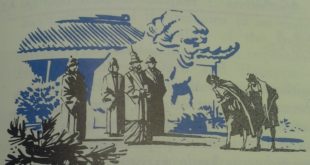DURING THE turbulent Five Dynasties and Ten Kingdoms era, the main outside threat to China came, as usual, from the north. A tough Mongol people from Manchuria helped one of the Chinese Warlords conquer North China. In return, he let them settle around Peking. Some of them became farmers, but their nomadic habits of roving and fighting remained strong. From time to time they raided the North China Plain, striking terror into the hearts of the peasants.
These troublesome people were called the Khitan. Another form of their name, Khitai, sounded like “Cathay” to European travelers who later came to China. Throughout the Middle Ages, China was known in Europe as Cathay.
In 960, the ruler of north China sent his best general after the Khitan to teach them a lesson. Instead, the general seized power and proclaimed himself emperor. As founder of the Sung dynasty, he was later called T’ai Tsu, or “Great Beginner.” Before he died in 976, he conquered most of China. His brother T’ai Tsung — “Great Ancestor”– conquered the rest, except for the Khitan kingdom in the northeast.

The Sung dynasty was to reign until 1279. A1though it started out boldly, it never became as powerful as the Han and T’ang dynasties. One reason was that the emperors deliberately kept their army commanders short of men and money to make sure they did not revolt. As a result, the empire was constantly menaced by barbarians. In the end, it was destroyed by them.
For generations, the Sung emperors bought peace by bribing the Khitan and a northwestern barbarian nation called the Hsi Hsia. Then a third barbarian nation entered the picture. In 1114, Manchurian nomads who called themselves the Chin, meaning “Golden,” attacked the Khitan. Seeing a chance to recover the long-lost northeast territory, Emperor Hui Tsung — “Excellent Ancestor” eagerly allied himself with the Chin. This proved to be a mistake, for after crushing the Khitan, the Chin continued south against the Sung. In dismay, the emperor abdicated, but in 1126 the invaders captured the Sung capital, Kai Feng and with it Hui Tsung and his son, the new emperor.
Another son of Hui Tsung called KaoTsung, or “High Ancestor,” rallied the Chinese to fight back, but from 1127 on, the Sung Empire was confined to central and southern China. This later and smaller Sung empire (1127-1279) is known in history as the Southern Sung.
PAINTING AND PORCELAIN
Hui Tsung had not shown much talent for foreign affairs. He possessed considerable talent in a very different field — painting. Like many gentlemen of his time, he was an enthusiastic amateur painter. In the Sung era, Chinese painting went through important changes. As Buddhist influence lessened, painters turned away from religious subjects to make pictures of the world around them. They painted landscapes and close-up views of nature, such as a sprig of blossoms. They used a style in which a few quick brush-strokes were all that was needed to depict quite complicated subjects. This style is what makes many Sung paintings look fresh and modern, even though they may have been painted as long back as a thousand years ago.

Like painting‚ pottery became highly developed. The porcelain wares turned out by Sung craftsmen have been called the world’s finest examples of the potter’s art. About 1030, porcelain was put to a new use — as type for printing. The invention of movable type, made of porcelain, wood and copper, made it possible to print books faster. Although separate pieces of type had to be on hand for each of the thousands of Chinese characters, it still took less time to set the pieces needed for a page together in a frame than it did to carve the complete page out of a single block of wood.
Thanks to this invention, many more new books were printed. They contained fewer new ideas. Educated men, writers and readers alike, were losing interest both in the religious spirit of Buddhism and the free spirit of Taoism. They turned to Confucianism, the most conservative and thoroughly Chinese of philosophies. They preferred to look backward rather than forward making history popular. The best-known written Work of the Sung era was the history of China by Ssu-ma Kuang (1018-1086), the country’s greatest historian since Han times.

Although China remained a farming nation, large numbers of people moved off the land during the Sung era. The cities, with their wine shops, tea shops, restaurants and theaters, offered excitements which the country lacked. In the slums of the growing cities, poverty, crime and disease spread rapidly. The movement to the cities also brought about a lowering of the position of women. In China, women had always been considered inferior. Often baby girls were killed at birth and women were hardly more than the slaves of their husbands. On the farms they performed useful work. In the cities, by contrast, there was nothing for them to do.
One result was the practice of foot-binding in upper class families. While they were still children, girls had their feet tightly wrapped and slowly bent until the arches were broken and the toes turned under. This produced a foot only about half normal size. Crippled, the girls could only hobble about on sticks. Men approved of this cruel practice, for it showed everyone how rich they must be to keep such useless creatures in style. In time, foot-binding was to spread to the countryside and down to the middle and lower classes. It was still being practiced at the start of the twentieth century.




